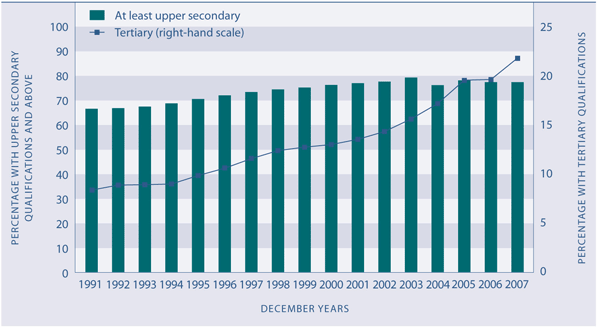Educational attainment of the adult population
Definition
The proportion of adults aged 25–64 years with an educational attainment of at least upper secondary school level, defined in the International Standard Classification of Education (ISCED 1997) as Level 3 and above, and including tertiary qualifications at bachelor’s degree and above (Level 5A/6).
Relevance
The educational attainment of the adult population is an indicator of the skills available in the economy. The level of formal educational qualifications in the population is a commonly used proxy for the stock of "human capital", ie the skills available in the population and labour force.
Current level and trends
In the year ended December 2007, 76 percent of the population aged 25–64 years (1.64 million people) had attained an educational qualification at upper secondary level or above. This was a slightly lower than in 2006 (77 percent) but a substantial increase from 67 percent in 1991. Over the same period the proportion of adults with a bachelor’s degree or higher qualification rose from 8 percent to 22 percent (472,000 people).
Figure K4.1 Proportion of adults aged 25–64 years with an educational attainment of at least upper secondary level and tertiary level, 1991–2007

Source: Statistics New Zealand, Household Labour Force Survey
Notes: (1) Tertiary equals bachelor’s degree or higher (2) This measure has been revised – see Appendix 2 for details
Age and sex differences
Younger adults aged 25–34 years are much more likely to have at least upper secondary school qualifications or a bachelor’s degree or higher than adults aged 55–64 years.
Sex differences in educational attainment have narrowed over time. For younger age groups, women are more likely than men to have higher qualifications.
Table K4.1 Proportion (%) of population aged 25–64 years with higher qualifications, by age and sex, 2007
| |
25–34 |
35–44 |
45–54 |
55–64 |
Total 25–64 |
| At least upper secondary |
| Males |
80.4 |
78.8 |
76.0 |
71.3 |
76.9 |
| Females |
83.9 |
78.2 |
75.0 |
60.7 |
75.3 |
| Total |
82.2 |
78.4 |
75.5 |
66.0 |
76.1 |
| Tertiary |
| Males |
25.7 |
22.6 |
19.7 |
17.3 |
21.5 |
| Females |
32.8 |
23.5 |
18.2 |
12.3 |
22.2 |
| Total |
29.4 |
23.0 |
18.9 |
14.8 |
21.8 |
Source: Statistics New Zealand, Household Labour Force Survey, December years
Notes: (1) Tertiary equals bachelor’s degree or higher (2) This measure has been revised – see Appendix 2 for details
Ethnic differences
Māori and Pacific adults are much less likely than adults in the European and Other ethnic groups to have higher qualifications. In the year ended December 2007, 63 percent of Māori and 50 percent of Pacific adults aged 25–64 years held at least upper secondary qualifications, compared with 80 percent of Europeans.
Similarly, just 9 percent of Māori and 8 percent of Pacific adults held a tertiary qualification at bachelor’s degree level or above, compared with 22 percent of Europeans. However, while the proportion of adults with a tertiary qualification at bachelor’s degree level or above almost doubled in the decade to 2007, it more than trebled for Māori and Pacific adults. The Other ethnic group (which includes Asians and, in 2007, the category "New Zealander") has consistently had the highest proportion of adults with a tertiary qualification, almost double that of the total adult population in 2007.
Table K4.2 Proportion (%) of population aged 25–64 years with higher qualifications, by ethnic group, selected years, 1996–2007
| |
European |
Māori |
Pacific |
Other |
Total |
| At least upper secondary |
| 1996 |
75.3 |
48.4 |
45.1 |
79.4 |
71.8 |
| 2001 |
78.8 |
59.9 |
65.8 |
85.1 |
76.8 |
| 2006 |
80.2 |
61.0 |
53.6 |
83.6 |
77.4 |
| 2007 |
80.1 |
62.9 |
49.7 |
72.7 |
76.1 |
| Tertiary |
| 1996 |
10.8 |
2.5 |
1.9 |
27.4 |
10.6 |
| 2001 |
13.2 |
5.0 |
5.6 |
32.0 |
13.4 |
| 2006 |
18.9 |
8.5 |
7.1 |
39.0 |
19.5 |
| 2007 |
21.6 |
9.4 |
8.4 |
39.3 |
21.8 |
Source: Statistics New Zealand, Household Labour Force Survey, December years
Notes: (1) In this data, Other includes Asian ethnic groups (2) Tertiary equals bachelor’s degree or higher (3) This measure has been revised – see Appendix 2 for details
International comparison
In 2005, 79 percent of New Zealand adults had at least upper secondary level qualifications, compared with an OECD average of 68 percent.52 New Zealand ranked 10th equal (with Finland) out of 29 OECD countries. New Zealand also ranked 12th equal (with Spain) out of 30 OECD countries in the proportion of adults who have bachelor’s degrees or higher, with a rate of 20 percent (just above the OECD average of 19 percent). Countries which had higher proportions of adults with qualifications at this level included the United States and Norway (each 30 percent – the highest rate), Canada and Australia (each 23 percent), and the United Kingdom (21 percent). New Zealand is among the 22 OECD countries in which females aged 25–34 years are more likely than males of that age to have tertiary qualifications at bachelor’s degree level or higher. |

